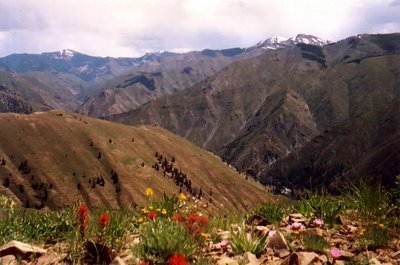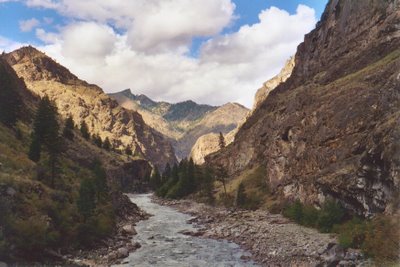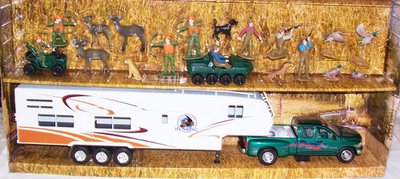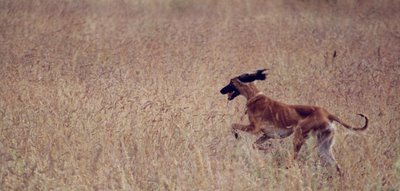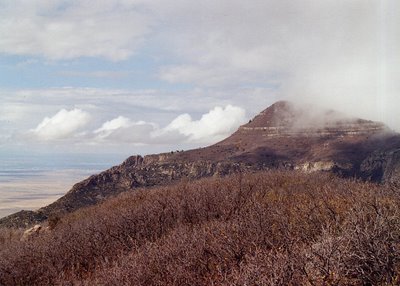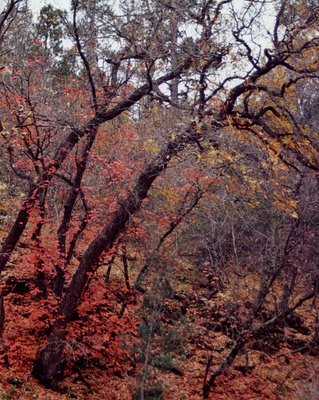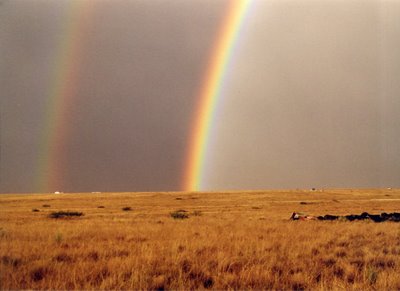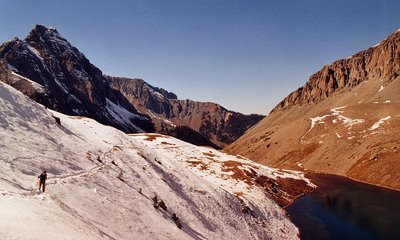"A bread pudding is not an alligator."Unfortunately, it was said by me. Context shall not be forthcoming. Happy New Year!
Sunday, December 31, 2006
Saturday, December 30, 2006
...Upon rereading, I suspect that the Germanic portion of my ancestry may influence me more than I had previously believed.
 Two Subarus that won't be moving for a while.
Two Subarus that won't be moving for a while.
Last night, an acquaintance of ours from out of state reported being told, when the snow was only 14" deep, "I've never seen the like in twenty years." I can only conclude that the speaker was one of Santa Fe's many two-weeks-per-years residents; we are afflicted with a great infestation of these tourist homeowners. It's nonsense, of course: it did this two years ago, and heavy snows, though not common, are hardly unprecedented.
We're not going anywhere for a while, so maybe I'll come up with some more posts.
Sunday, December 24, 2006
To our amazement we learned that in valleys [in the Karakorum] where glaciers had disappeared, sometimes new, artificial glaciers are constructed by villagers. Glaciers are treasured in this dry country, for meltwater is the source of practically all irrigation. The last glacier to be started, we were told, had been made 35 years earlier by the grandfather of the present rajah. It had been built to an ancient formula, with ice blocks coming from male and female glaciers (their difference was not made clear). These blocks were deposited in a high valley and covered with charcoal and thorn bushes, on top of which 50 goatskins of water were placed. The water was to help keep the ice cool and to augment the ice supply when the water froze in winter. After 20 years of gradually adding ice and snow, the glacier became strong enough to support itself and send a constant supply of water in the nonwinter months to the dry fields below.From Robert H. Bates' account of the 1932 K2 expedition, told in The Love of Mountains is Best, pg. 119.
Thursday, December 21, 2006
The Peculiars will not be staying to enjoy Santa Fe's white Christmas, alas. We're off to, well, I'll just say it's where a lot of folks from my parts of the country got sent to die. If I'm lucky the trip will involve a prodigious great arroyo and a steakhouse depicted on The Simpsons. Best wishes to you, gentle readers, this festive season! We leave you with our take on a creche.
Let all of creation rejoice:
Finally, Mr. Armitage's shock and awe at the gralloching of a deer are comically professorial.
Sunday, December 17, 2006
Fine, I admit it, I finally broke down and went digital (Canon A540, if you're dying to know). I held out for a long time in the stubborn hope that I could muster the funds for a DSLR. But frankly, I could not have made the shot above (six-shot stitched pano) with my old film SLR, much as I love it. The new one is a lot of fun, and if I'd gotten it a year ago, I'd be about $300 ahead on processing costs. Farewell film: $300 buys a damn fine week or two shooting in the wilderness.
If I was having any twinges of buyers' remorse after ordering the new camera, it was gone when Mrs. Peculiar and I fortuitously watched Born Into Brothels. Looking at some of the shots these Indian street urchins produced with cheap point-and-shoots should put any gear-head photographer to deep, deep shame. (Here they are. Some are definitely better than others, but I'm seriously envious of a few.) Sure, I'd like a wider lens, but I have no right to gripe about any reasonably functional camera.
(Incidentally, it's well worth noting that Calcutta whorehouses seem to be a much better learning and growing environment than American suburbs and schools. These kids are far nicer, cheerier and smarter than 99% of American children; I'd invite them into my house. The movie doesn't preach about this, doesn't preach about much really, which I always fear in this kind of film. It's mostly just footage of a bunch of smart kids having fun with photography.)
Enough digression. I promise not to post every consarned gorgeous sunset that comes down the pike.
Saturday, December 16, 2006
I recently stumbled across a historical maniac quite new to me in this old John Derbyshire column:
The Seven 'Kill' Stele was erected by Zhang Xianzhong (pronounced "Jang Shee-en Jwoong"), one of the worst mass murderers in Chinese history, which is saying a very great deal...I read French, and if anyone knows of a copy, I'll take it in either language.First he killed all the educated people — always a strong temptation for the would-be Chinese despot, apparently, when megalomania begins to assert its grip. Zhang ordered all the literati of Sichuan to Chengdu, his capital, for a "special examination". Once they were there, he massacred them. Next he killed all the Buddhist clergy. Then he broadened his field of operations, and began killing at random. His intention seems to have been to exterminate the entire population of Sichuan, at that time probably around twenty million. He very nearly succeeded, if the oral tradition can be believed. Hu-Guang tian Sichuan, say local people with a shudder and a shake of the head: that is, there were so few people left alive in Sichuan after Zhang was through, the province had to be re-populated from the "Hu" and "Guang" provinces (Hunan, Hubei, Guangxi, Guangdong). When he ran out of people to kill, Zhang turned his fury on the inanimate world: he set his troops to pulling down buildings, broaching dykes and burning forests.
When news came that forward scouts of the Manchu armies had been spotted in the north of the province, Zhang gathered all his men together on a plain outside Chengdu. He made a speech to them along the following lines: "The great battle for the Empire is about to begin. I want you all to fight like true soldiers, with nothing on your minds save the thought of victory. To make sure you are not distracted or weakened by other concerns, I hereby order you to kill your womenfolk and your children." To give the example, Zhang thereupon turned, drew his sword, and slew his eight wives, who were standing by him. Thus inspired, his troops all butchered their own families, until the ground was soaked with the blood of these innocents. Zhang then rode out to meet the Manchus. Fortunately the Manchus were terrific archers, and a well-placed arrow ended the career of the "King of the West"...
At some point in his career of homicide, Zhang felt it necessary to explain himself to the world. He therefore caused a stele to be erected, inscribed with the following three lines of seven Chinese characters each: Tian sheng wan wu yi yang Ren, Ren wu yi shan wei bao Tian, Sha sha sha sha sha sha sha. Here is a translation (with, for a Chinese reader, an understood "but" between first and second lines, and a "therefore" between second and third):
That was the Seven 'Kill' Stele. It was still standing outside Chengdu well into the last century. Five or six years ago I asked a friend visiting the city to try to locate it for me. However, the local authorities told her it had been blown up by a PLA demolition squad sometime in the 1970s.
Heaven has brought fourth numberless things for the nourishment of Man.
Man does not do one good deed in recompense to Heaven.
Kill kill kill kill kill kill kill.It is a measure of the moral atmosphere of Chinese communism that this revolting psychopath, on account of his early land-to-the-peasants moves and his patriotic opposition to the Manchus, is rated as a "positive character" in communist history books — even, in one 1979 encyclopedia, a "hero of the common people".
N.B. Zhang had a Portuguese Jesuit in his entourage, who survived and wrote a book in French about his experiences. The School of Oriental and African Studies in London has a copy. Alas, I cannot read French. If anyone knows of an English translation, I should very much like to get a copy.
Anyway, I'm sure the books contents will be familiar to most people who have ever had much conversation with me. "More breeds than of dogs; uncanny homing abilities; remarkable long-distance races; champions selling for ridiculous sums; pigeons decorated war heroes." I wonder whether the author found out about the pigeon vendettas among Italian thief-pouter flyers. You've heard it all before. I certainly wish the author well, but it's always a little galling to be reminded how little expertise in a subject has to do with publishing a book on it. I could have written this book; Steve Bodio did write this book, quite some time ago. Sigh. So ist die Lauf der Welt.
I've added GOAT-A High Country News Blog to the sidebar. High Country News is a very fine source for updates of the state, whether laudable or deplorable, of the Rocky Mountain West. (Hat tip: Chas, of course.)
Friday, December 15, 2006
Hard on the heels of our moment of international repute, we have here more content you will not find elsewhere on the much-vaunted "World Wide Web." Below is I believe the only extant image of the entire Querencia pack, five tazis plus a lurcher and a wiener dog. Before last summer, the three big tazis represented 100% of the breeds Western Hemisphere population. Now, the five depicted represent approximately 40%, I'm happy to report.
Friday, December 08, 2006
Thursday, December 07, 2006


The folks at Querencia are always blogging rock art, so I was inspired to do the same when I found a couple long-forgotten photos in an old trunk. These pictographs represent a very obscure tribe, the Sheepeater Shoshone of central Idaho (also sometimes called the Tukudeka). Both of these small panels are found near the Middle Fork of the Salmon River, one of the deepest and wildest river canyons in the nation. They are probably painted with iron oxide pigment mixed with animal fat and blood. The bird and bighorn (below) seem clear enough, and the well-endowed gentleman is a common enough theme in the area. One excellent panel, unfortunately not shown here, is called by names which vary according to rafting company: Shark Fin, for the prudes, after a distinctive boulder in the river nearby; One-Hung-Low by my compatriots; Big Chief Long-Dong by the unapologetic.
There are plenty of things to say about the Sheepeaters. They were a Numic-speaking people (like other Shoshone, Paiutes, Bannock, Goshutes and Utes). Beginning around the 15th Century, the Numic speakers spread from somewhere around Southern California to fill Nevada, Utah, the southern half of Idaho, western Wyoming and western Colorado. These tribes shared closely-related languages and common lifestyles of hunting-gathering and seasonal migration up into historic times.
Dagger Falls: some rock art is present here, though very deteriorated. Salmon can still be observed leaping up the falls in season, and the fishing here must have been excellent in Sheepeater times.
The effects of the European arrival were felt in the American West long before any actual Europeans showed up. Most notably, the Spanish brought horses into New Mexico, which soon escaped and went feral, and were gathered or stolen by the locals and traded northward. By the late 1700s, they'd made it to the Northern Rockies, and local lifestyles changed dramatically as a result. Tribes such as the Nez Perce, the Shoshone and the Utes were suddenly able to cover distance and carry a lot; they therefore began making seasonal expeditions east to the plains to hunt buffalo. The Plains Tribes responded by raiding them (particularly the Blackfeet, who got guns from Canadian fur traders ahead of everyone else). These tribes from the western slopes of the Rockies thereby acquired many accoutrements of Plains culture, such as feathered headdresses and tipis (which they could now transport), and became generally more nomadic and combative of necessity.
These changes took root very near the Sheepeater country. In the Lehmi Valley, around the present-day town of Salmon, Idaho, the Lemhi Shoshone bred horses and made the short hop over the Continental Divide to chase buffalo. Every halfway educated American is dimly aware of this, for it was one such hunting expedition that got Sacajawea captured by Mandan and taken to North Dakota; and it was successful Lemhi horse breeding that allowed her brother Cameahwait to give some animals to Lewis and Clark in 1804.
The Middle Fork country from high up: a small piece of river is visible lower right. The pink flowers are Bitterroots, endemic to eastern Idaho and western Montana, and an important food for local tribes.
While their Shoshone relatives in the broad valleys and plains of southern Idaho and Wyoming went along with this flow, the Idaho Sheepeaters are fascinating because they ignored these developments. Unlike the Lemhi Valley, Central Idaho just to the west is not good horse country; the Salmon River Mountains are a dense, incoherent knot of rugged peaks and very deep canyons. Furthermore, neither the river system nor the tribe was named at random: the biannual salmon migrations and the prolific bighorn sheep populations provided abundant resources for the Tukudeka. Though they continued their short seasonal migrations from high-elevation hunting grounds to low winter settlements, the Sheepeaters continued to winter in Northwestern-style pit-houses (there are many visible collections of house-pits on the Middle Fork), catch salmon and hunt sheep.
Typical river terraces where the Sheepeaters would build their house-pits. These were winter quarters with good exposures to sun and fairly low elevation. Much of the Middle Fork flows through a semi-desert environment, due to rain shadow effects of the surrounding mountains.
The few ethnographers who were aware of them at all long assumed that the Sheepeaters were degenerate hillbilly Shoshones, living a benighted existence in the mountains and evidently unable to find anything better to do. In fact, the Sheepeaters were known for excellent quality hides; they tanned one sheep's hide with two sheeps' brains, producing a valuable item that was traded for foreign commodities (notably obsidian; stone from both Yellowstone and the Cascades has been found in the area), and not a mark of abject poverty. Furthermore, there is no record of the Sheepeters eating grasshoppers, common practice among the Plains Shoshone and Bannock. Eating salmon instead of bugs is usually a sign that one is fairly well-off.
Sadly, the Indian Wars of the 1870s did not bypass this small and out-of-the-way tribe. 1876 was the year of the Little Big Horn; '77 saw the Nez Perce War; '78 the Bannock War in southern Idaho and eastern Oregon. In 1879, the Sheepeaters were one of the last unfought tribes in the Northwest. Unknown assailants killed a family of settlers near the South Fork of the Salmon, and some Chinese miners were murdered on the Yankee Fork, almost certainly by whites. It was easy to blame the Indians, and the merchants in Boise agitated for war. One wrote unabashadly in 1878 of eastern Oregon's "good fortune to have an Indian war and the concomitant shower of greenbacks all to itself."
Rough country for infantry: the army traversed a lot of this terrain, with mules, supplies and small artillery.
Two army columns were sent into the Salmon River Mountains, one from the south and one from the east. Their journals tell a rather farcical story of ten-foot-deep snowdrifts, blazing sun in the canyons, rattlesnakes, mules frequently tumbling down the slopes, but nary a sign of an Indian. Central Idaho is convoluted country, and the army was out of its depth. When one column at last met resistance on the slopes above Big Creek, the lieutenant promptly distinguished himself by hiding behind a tree. The soldiers were pinned down for over 36 hours and resorted to drinking vinegar (the site is named Vinegar Hill); the sound of Big Creek's cascades below must have been irritating in the extreme.
The Middle Fork near the confluence with Big Creek. The false summits in the photo are nowhere close to the top of the canyon, which rises 7,000 vertical feet in five horizontal miles from river to summits in this area.
At last, the army got lucky and captured a small group of women and children, along with one man, a Bannock refugee from the previous year's war. Desperate at this point to save face by returning from the mountains with a vaguely respectable number of Sheepeaters in tow, the lieutenant cut a deal with the Bannock. He led them to a Sheepeater camp, they rounded up the Indians and marched in dubious glory to Fort Hall in southeastern Idaho, still a Shoban (Shoshone-Bannock) reservation today.
There were undoubtably Sheepeaters remaining in the mountains after that summer, but the loss of even a small group was surely a major blow to so small and isolated a tribe. As we have seen above, they did rely at least somewhat on trade for their living, and there were no longer any free tribes nearby to trade with. What's more, central Idaho was declared open, and miners poured in. There is no direct record of what happened to the remaining Sheepeaters, but it seems safe to assume that they gradually headed south to the reservations. There they intermingled with plains Shoshone, Bannock and Northern Paiutes, and all intimate knowledge of the West's most isolated people, the tribe least changed by horses and guns, was lost.
The army named the lower reaches of the Middle Fork 'Impassible Canyon', but Shoshone pictographs are particularly abundant in these mazes of cliffs.
Source: The only book I know with a significant amount to say about the Sheepeaters is The Middle Fork: A Guide by Cort Conley. It includes extensive and often quite amusing excerpts from the soldiers' journals in the Sheepeater War. The Wikipedia entry on the Sheepeater War is laughably ill-informed. Particularly risible is this: "Sheepeater raiding party of ten to fifteen Indians attacked the troops as they rode on a train at Soldier Bar on Big Creek." The author is clearly thinking of a locomotive, but the only trains ever to have entered the Salmon River Mountains are equine, thank God!
(Final remark: the cohabitation of this post with Odious' charming tipi photograph is purest coincidence.)
All photographs are my own.
Monday, December 04, 2006
Via The Athanasius Kircher Society, which has been having a wonderful language week.
Friday, December 01, 2006
To quote the immortal film Conan the Barbarian, "Five years ago, it was just another snake cult."
Buried beneath utterly dreary headlines about Oldest Form of Worship and suchlike is this story: "An archaeologist claims to have found evidence of what may have been mankind’s earliest rituals: worship of the python, 70,000 years ago in Africa." The most sober and informative article I've found is here. Located in San (Bushman) territory in Bostwana, the site features what is allegedly a stone "carved to enhance its resemblence to a snake." Unfortunately the photographs are insufficient to judge for oneself, for me at least. What's more,
Hundreds of small notches, widely spaced in some places and closer together in others, covered the rock. Entrants to the cave apparently made these markings to enhance the snake illusion by creating the impression of scales and movement. "When flickering light hits it, it very much looks like the snake is flexing," Coulson says.An aspect of rock art you don't hear much about is the carving of stones to enhance their resemblance to something. I recall that such was the exegesis of one stone in Fremont Indian State Park in Utah: it had had a few marks added to make it look like a bird with its head tucked beneath a wing.San mythology holds that mankind descended from the python. Ancient, arid streambeds around the hills are said to have been made by the snake as it circled, ceaselessly seeking water.
More rock art coming.
Thursday, November 30, 2006
Also, new understanding of the workings of the Antikythera Mechanism. Please give us a working replica and a virtual online version with explodable innards.
Update: As to the latter, Reid Farmer has more and better.
Tuesday, November 28, 2006
Sunday, November 26, 2006
As Convent Garden's stagehands are alleged to have protested, though rocks were in their contracts, "Them's not ordinary rocks, them's Wagnerian rocks."
Ah, the essence of hunting, the champagne air of Autumn, the healthy meat, morning frost, well-heeled guns and well-oiled dogs, the family fifth wheel! Note the fawn with spots still on it: should someone inform the earnest bowmen that their tags don't count on those?
The most usual Cure for Agues in this Country [Georgia] is to make Plaisters of the Fat of a Sheeps Rump, Cinamon, Cloves and Cardamomes, and all the time of the cold fit to lay these Plaisters upon the Forehead, Stomach and Feet. When the hot fit is over, take off those Plainters and lay on others, made of the Leaves of Chihory, Plantain, and the Herb call'd Solanum or Nightshade, afterwards they take a Sucking-Pig, cut in two and clap it to the Feet. All which time the Patient is fed with Bread and Cream of Almonds, eating nothing that is boyl'd.I believe Mr. Bodio receiv'd a similar Treatment in his Voyages to Kazakh Tartary, tho' in his Case involving Slabs of Horse-Flesh, which Procedure was successful.-- The Travels of Sir John Chardin into Persia and the East-Indies (1686), quoted in The Georgian Feast
Tuesday, November 21, 2006
While we're on the subject, here's one of the better bits of mountain poetry I've read, though the Taoist visions do become a tad heavy. Dreaming I Roamed on TianMu Mountain by Li Bai (701-762):
A seafaring visitor will talk about Japan,Courtesy of John Derbyshire
Which waters and mists conceal beyond approach;
But Yueh people talk about Heavenly Mother Mountain,
Still seen through its varying deeps of cloud.
In a straight line to heaven, its summit enters heaven,
Tops the five Holy Peaks, and casts a shadow through China
With the hundred-mile length of the Heavenly Terrace Range,
Which, just at this point, begins turning southeast.
...My heart and my dreams are in Wu and Yueh
And they cross Mirror Lake all night in the moon.
And the moon lights my shadow
And me to Yan River –
With the hermitage of Xie still there
And the monkeys calling clearly over ripples of green water.
I wear his pegged boots
Up a ladder of blue cloud,
Sunny ocean half-way,
Holy cock-crow in space,
Myriad peaks and more valleys and nowhere a road.
Flowers lure me, rocks ease me. Day suddenly ends.
Bears, dragons, tempestuous on mountain and river,
Startle the forest and make the heights tremble.
Clouds darken with darkness of rain,
Streams pale with pallor of mist.
The Gods of Thunder and Lightning
Shatter the whole range.
The stone gate breaks asunder
Venting in the pit of heaven,
An impenetrable shadow.
...But now the sun and moon illumine a gold and silver terrace,
And, clad in rainbow garments, riding on the wind,
Come the queens of all the clouds, descending one by one,
With tigers for their lute-players and phoenixes for dancers.
Row upon row, like fields of hemp, range the fairy figures.
I move, my soul goes flying,
I wake with a long sigh,
My pillow and my matting
Are the lost clouds I was in.
...And this is the way it always is with human joy:
Ten thousand things run for ever like water toward the east.
And so I take my leave of you, not knowing for how long.
...But let me, on my green slope, raise a white deer
And ride to you, great mountain, when I have need of you.
Oh, how can I gravely bow and scrape to men of high rank and men of high office
Who never will suffer being shown an honest-hearted face!
--Trans. Witer Bynner
We're off. Happy Thanksgiving!
Tuesday, November 14, 2006
Not so inspiring is the story of David Sharp, who in 2006 had his last words captured on film high on Mount Everest. The filmmakers lacked skis and spoke a different Germanic language, but they followed in the footsteps of their spiritual ancestors in mountaineering: they took their film and left.
If any of our readership is sufficiently TV-literate to be checking out the Discovery Channel’s new Mt. Everest show, which premiers tonight and which I will not link, you should read this resounding excoriation from MountEverest.net. I knew that many people walked past David Sharp, spoke with him and left him to die in the snow. I was unaware that some of his last words were filmed by this crew, a clip you will not see tonight, nor likely ever. The linked article is admittedly biased, and legitimate rebuttals could be made to some of its assertions. However, the main point definitely stands. This team had the material resources to get a film crew up there, but lacked the moral resources even to consider helping a human being get down. It can be done. It would even have made some remarkably inspirational television. Skip Discovery’s Everest conga-line circus: your soul would be better off watching South Park reruns. Or you could read Tigers of the Snow, learn about the Nazis’ inhuman callousness towards their sherpas and wonder why modern climbers can’t do any better.
Wednesday, November 08, 2006
Tuesday, November 07, 2006
You're better off with resonance where your brains ought to be. The rest can be fed into you unless you're retarded. I've known a lot of quite successful singers who are quite retarded.You'll also hear a marvellous bit of one of her Gilbert & Sullivan parodies. For more of the like, watch this.
Monday, November 06, 2006
Meanwhile Mike Golding, the leading Brit in the race, was also in a good mood this morning despite an incident with a giant squid, which has covered his hull and the lower part of his sails in ink. Mike Golding commented: "The decks and even the foot of the head sail were covered in what looks like squid ink and there's an awful lot of it. It looks like it was shot from ahead. Whatever it was, it was pretty big, but I'm not worried - I'm bigger!"Thanks Deep Sea News.
Friday, November 03, 2006
Posting on the book seems to require little explanation; it's a decent book, and certainly succeeds in "consciousness-raising" or what have you--getting people's backs up, more or less. But it's strangely at right angles to the actual problems and questions of theism, let alone religion. I don't really need a new critique of Aquinas' five ways, and if I did I'd go elsewhere. Dawkins' misunderstanding of some fundamental tenets of theology leads to some amusing statements.
This is not to say that he hasn't a point. He has an enormous number of them, but he makes so many so loudly that catching the babies in this sea of bathwater is no easy task.
So much for saying something. As for not saying something: reading the book I started thinking about Richard Dawkins. What sort of e-mails he must get, the sort of horrible Case for a Creator nonsense he must hear day in, day out until frankly you could just shoot somebody. Heaven knows I feel that way often enough. So I decided that, since the book isn't for me anyway, I didn't have anything to add to the discussion. Richard Dawkins must be very tired. He's become a sort of avatar of atheism, and if that isn't an unpleasant irony I don't know what is. I repent of the petty nastiness back during the introduction of "bright", and I look forward to his next book on evolution and biology.
Thursday, November 02, 2006
France and the Low Countries
Hosted for centuries
Much to their shame
Prattle of dualist
Anticarnality--
Christ was a phantom or
So they would claim.
And:
XENOPHYSITE we name such men
As think God quite beyond all ken;
They question holy revelation
With anaphorists' argumentation;
Conclude that Christ was but a man,
And thus deny His heav'nly plan.
They are quite rightly burned alive
That such a creed may never thrive.
A.
B.
Q.
Per request from La C.C., 'M' shall not be 'Monophysite'. Also, I know that the double dactyl is not, strictly speaking, such.
Monday, October 30, 2006
(Via Natalie Solent)
Tuesday, October 24, 2006
Sunday, October 22, 2006

 Das wüthende Heer: right to left, Plummer (lurcher), Ataika, Larissa (pretty sure), Lashyn (forequarters).
Das wüthende Heer: right to left, Plummer (lurcher), Ataika, Larissa (pretty sure), Lashyn (forequarters).
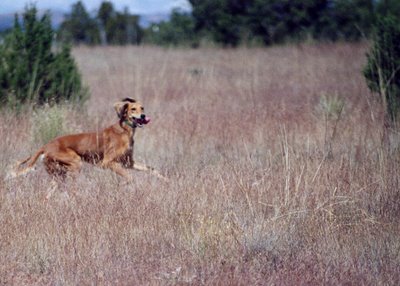
 Kiran, the male tazi. Tazi bitches like to be fea, fuerte y formal; Kiran not so much.
Kiran, the male tazi. Tazi bitches like to be fea, fuerte y formal; Kiran not so much.
I really should come on one of these outings with more than half a roll of film. It's no problem at all to burn through frmaes tracking lightning-swift dogs through the New Mexico savannah. I took my last shots as we looped back around towards the car. Very shortly after, I was walking ahead of eveyone else, and bumped a jackrabbit. I yell, "Hai! Hai! Hai," the dogs are conveniently near, the pack wheels and pursues. Tazis seem fast at a lope, remarkably fast at an excercise pace; but these speeds are nothing compared to their pursuit. Already rocketing, the dogs suddenly engage a whole 'nother gear, flying ahead towards the rabbit, who suddenly realizes that these are not like other dogs and that he's actually in a good deal of trouble. A cottontail would be doomed, but jacks can fly along themselves, and twist and turn. The hare carves a serpentine path across the fields, a whiplash of sighthounds following and gaining. At one moment, the jack is running straight at me, the line of dogs behind, closing the gap on the straightaway; my camera, of course, remains empty. More twists, more pursuit. Lashyn is a noselength behind when she slips on a patch of mud. The hare escapes by the skin of its teeth.
******************************
Saturday, October 21, 2006
It is to be supposed that the last family of Atures did not die out until a long time afterwards: since at Maypures - bizarrely - there still survives an old parrot that nobody, say the natives, can understand, because it speaks only the language of the Atures.The only record of the Ature language was preserved by a bird! Hat tip: dr.hypercube.
Friday, October 20, 2006
Thursday, October 19, 2006
Two weeks ago, we headed to Magdalena to visit the Bodios. Unsurprisingly, we ate well and drank much, and saw some brilliant sunsets in joint celebration of two couples' anniversaries. On Sunday, we went out, accompanied by two tazi bitches, to Central New Mexico's Manzano Mountains, a place I had visited previously alone.
The Manzanos are not a mountain range you'll hear much about. They wouldn't do well on postcards or in Sierra Club calenders. They top out at just barely over 10,000 feet, which would be a pretty respectable summit in Idaho or Washington; down here, its not that high, well below the timberline. To put it bluntly, not too many people are interested in these mountains, and I'm optimistic that not many ever will be.
So why should one go, with Colorado's spectacular peaks beckoning not to far to the north? In short: for biodiversity. The Manzanos, particularly in their northeastern quarter, are remarkably well served with rainfall, and the vegetation is explosively lush by Southwestern standards. You sense immediately that you are no longer in the Southern Rockies, as up by Santa Fe. The ubiquitous pinon and juniper are present of course; the nearby Rockies contribute spruce, fir and a few aspens; and the ponderosa pines are very tall and prosperous. But the conifers are largely punctuation set within extensive groves of oak and bigtooth maples. Deciduous trees are always a novelty in New Mexico, and these lush, vast stands of broadleafs are unheard of.
The Manzanos, like their neighbours on either side, are a block-fault range formed by the Rio Grande Rift, asymmetrical, with a steep western scarp falling towards the flats by the river, in contrast to hillier and gentler eastern approaches. As we drove up out of the rift on our way to the trailhead, over Abo pass, rain began falling heavily, steaming the car, defroster struggling and windows cracked. We couldn't see the mountains at all through the clouds and rain as we drove north to the trailhead, our optimism for the hike on the wane. These eastern foothills of the Manzanos were one of the first areas of European settlement in New Mexico outside the Rio Grande valley. The ruins of large churches and extensive settlements are scattered about the area: Abo, Quarai, Gran Quivira. This is the far uphill edge of the Great Plains, and the Indians gathered salt on flat playas to the east for trade. As the story goes, the first Spanish traders who ventured out of the valley seeking the source of the salt found mature apple trees growing here, apple trees whose zeal to colonize evidently outdid that of the conquistadors and missionaries. (Apples, if you've forgotten, come from the Altai mountains in Kazakhstan.)
Some modern settlements hang on out here as well. Estancia and Mountainair are down-at-the-heels high plains towns, with some splendid old brick buildings and ranch houses and not much else, sustained by the railroad and the ranches to the east, flanked on the west by the Manzanos and on the south by the cloven, haunted, empty badlands of the Los Pinos mountains. Closer to the mountains are several Spanish land grants and their eponymous villages, Punta de Agua, Manzano, Torreon and Tajique, beautifully run-down Spanish villages laced with seasonal creeks from the mountains, of the sort that have mostly been bought out by yuppies up north. We drove past perfect village churches, skeletons of gers, hogans, undefinable structures, general stores; there's a Sufi center outside of Torreon. At Tajique we hung a left up a canyon of high plains sandstone strata tilted up by the rift, into increasingly opulent vegetation.
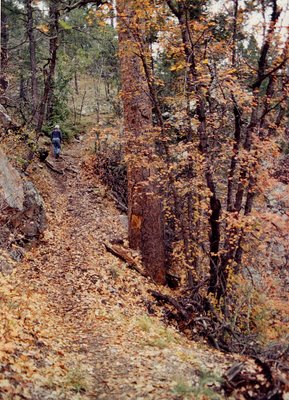
 The rain broke. We walked uphill towards the crest. The tazis pushed ahead, but even they were largely kept to the trail by the dense oak underbrush. We had come hoping for fall colours in the state's best deciduous wood. We found a little bit of everything: lots of bare trees, the ground strewn with brown; lots of lush green stands looking determined not to acknowledge autumn one bit; and a few brilliant splashes of orange and red fall brilliance. When I had come here before, in late summer, there had been many wildflowers. A few lingered on under the autumn canopy: Jacob's ladders, harebells, many I didn't know. Small, trickly waterfalls in the gullies provided a soundtrack.
The rain broke. We walked uphill towards the crest. The tazis pushed ahead, but even they were largely kept to the trail by the dense oak underbrush. We had come hoping for fall colours in the state's best deciduous wood. We found a little bit of everything: lots of bare trees, the ground strewn with brown; lots of lush green stands looking determined not to acknowledge autumn one bit; and a few brilliant splashes of orange and red fall brilliance. When I had come here before, in late summer, there had been many wildflowers. A few lingered on under the autumn canopy: Jacob's ladders, harebells, many I didn't know. Small, trickly waterfalls in the gullies provided a soundtrack.
We had also come hoping to see birds of prey at the crest. Early October is raptor migration season, indeed Hawkwatch maintains a seasonal site in the Manzanos, but as we ascended through thick tendrils of mist worthy of a Chinese landscape, our hopes for birds diminished. We did see bear excavations in the soil.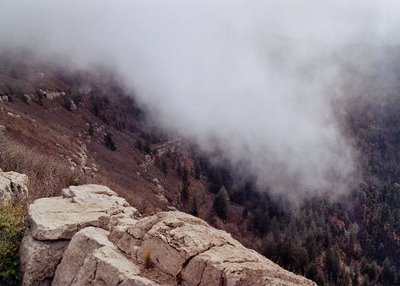

Toward the crest, the larger trees thinned out, leaving only a head-high carpet of dense scrub oak. We were not optimistic about views, but as we reached the top the mists began rolling back as if on request, and we looked down the steep western slope of the mountains, striped with limestone terraces, to the broad plain stretching out toward New Mexico's great river. Steve, with his almost supernatural radar for avian life, picked out two sharp-shinned hawks at the top; I caught a fleeting glimpse of the second as it vanished into fog.

 As we descended, the mist moved back in and threatened more rain.
As we descended, the mist moved back in and threatened more rain.
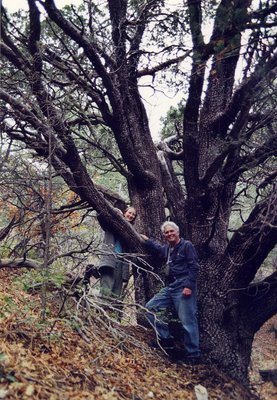
 Steve and Mrs. Peculiar show off a truly enormous Alligator Juniper, prime specimen of Manzano Mounatin fecundity!
Steve and Mrs. Peculiar show off a truly enormous Alligator Juniper, prime specimen of Manzano Mounatin fecundity!
We drove out through the back roads, through idyllic mountain valleys, the kind that leave you wondering how many people it would be necessary to kill to own the place. My Subaru came through admirably, as always (Cars like flattery! And rugged outings!), in the thick patches of rain-sodden mud. We passed the sufi center and popped out at Torreon in another driving rainstorm. The precipitation in Central New Mexico that weekend was off the charts. We saw numerous arroyos flooding on the drive back to Magdalena, always a cheering sight. (Although Utah really received the brunt of the flooding: hundred-year records! Here also!) As we came back down Abo Pass, well, I'll let a better writer choose the words:
On the way back we drove into the heart of a thunderstorm, backlit by the sunset; descending the steep western slope was like flying into it in a plane. We drove through and looked back to see what we all agreed was the most perfect rainbow we had ever seen, a complete arc backed by the nearly- black thunderhead but rooted in the golden plain.
In Central New Mexico, you don't get a pot of gold at the end of the rainbow, you get piles of tires and meth shacks! Thank God it's been a rainy year: New Mexico's squalor receives just as much rain and beautiful atmosphere as its opulence!
Please view the pictures at full size, if you are so inclined. Coming up: the Manzano Mountains, and tazis!

Mrs. Peculiar looks down on the second of the three Blue Lakes. 
The blessing of an intrepid wife! 










